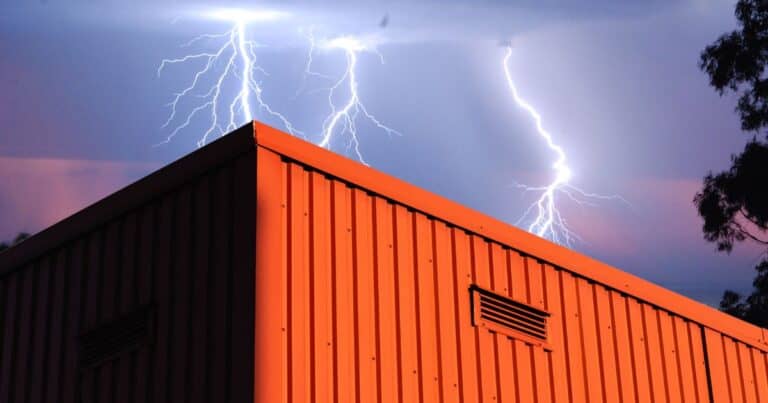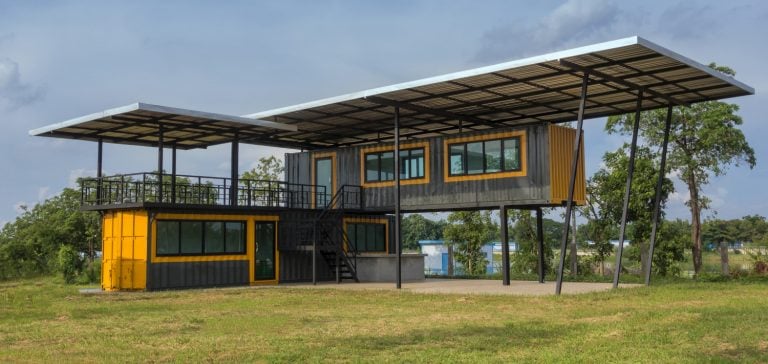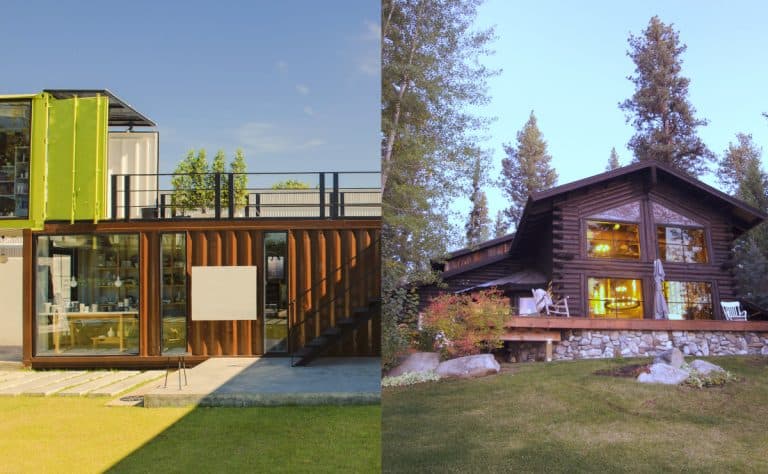Don’t Container Homes Get Hot? 14 Ways To Stay Cool
Container homes can get hot, but there are many efficient ways to cool them for a comfortable living space. Here you will find many cost-effective ways to regulate the indoor temperature of a container home.
Many of these methods are a little outside-the-box (pun intended). For example, one of the most fun and aesthetically-pleasing ways to make a container home cool is a rooftop garden. These unique ways prevent overheating and can also help you save money that you would otherwise have spent blasting an air conditioner all the time.
How Can I Cool Down My Container Home?
Air conditioning a house made of metal can seem like a challenge initially. Fortunately, there are many solutions to make the living space comfortable. You can always just blast an air conditioner, but these solutions are designed to reduce energy costs and potentially allow you the opportunity to keep your house off-the-grid.
14 efficient ways to cool down a container home include:
- Spray-On Insulation
- Ceramic Coating
- Reflective Foil Insulation
- Radiant Barriers
- A living roof (a fun outside-the-box idea)
- Passive Solar Cooling
- Window Overhangs/Awnings
- Natural Ventilation
- Whirlybird Ventilation
- Energy Recovery Ventilator
- An Evaporative (Swamp) Cooler
- Portable Fans
- Solar-Powered Cooling
- Low-E Windows
Why Do I Need To Insulate A Container Home?
Properly insulating any house will assist you vastly in being able to regulate the interior temperature of that house. Those who are interested in moving into container homes tend to underestimate the value of proper insulation.
Insulation is needed in homes thanks to competing forces of interior and exterior temperatures, which are much more pronounced in some climates versus others. If there is a difference between the interior and exterior temperatures of a home, then the temperature at both ends will change until they are the same.
If the inside of the home is air-conditioned, then the more pleasant air will move out, and the warmer air from outside will move in during a type of heat transfer called conduction. This rapid transport of air can be delayed with proper insulation. Naturally, container homes are not very well insulated since they are made of metal.
How Do I Insulate A Container Home?
One of the most effective ways to prevent heat from accumulating inside the house is to insulate the walls properly. Proper insulation will reduce the impacts of heat transfer that will, in turn, leave your home feeling hot and stuffy. It will also help reduce energy costs.
Don’t Use Fiberglass Or Wool Insulation
Traditionally homes have been insulated using materials made of wool or fiberglass. These are not effective materials for insulating a container home. Fiberglass and wool are not effective insulators for container homes because they are subject to corrosion. Fiberglass and wool also may lead to excess condensation on the interior walls of the home.
Using Spray-On Insulation In Shipping Containers
Spray-on insulation has been noted to be a good insulation material for container homes. Closed cell-spray insulation is a popular choice for insulating the walls. One popular spray-on insulation material for such use is spray-on polyurethane foam. Options include kits such as the Froth-PAK Insulation Kit.
It is standard practice, as is noted here, to install 1.5″ of closed spray foam in container homes. The foam is added to all metal walls and ceilings. Spray-on foam is a relatively simple type of insulation to install on walls and ceilings since the spray guns tend to have a good range.
Ceramic Coating Will Help You Cut Down On Energy Costs For Your Container Home
Ceramic coating is a go-to material for insulating shipping container homes. Extensive research has shown that ceramic coatings help homeowners cut down on energy costs. Ceramic coatings act by preventing both heat loading and heat transfer in the metal containers. Metal is a material that is particularly susceptible to heat loading.
Not only do ceramic coatings act as effective insulators, but they also act as a:
- Layer of fireproofing
- Acoustic barrier
- Paint layer improving the aesthetic appeal
- Energy Saver
Ceramic coatings work best when they are applied to the exterior of the shipping container, in conjunction with polyurethane foam that is added to the interior. Ceramic coatings are easy to come by. You will often come across ceramic coatings that are marketed specifically for vehicles, as is the case with the LizardSkin White Ceramic Insulation.
Reflective Foil Is Easy To Install And Is Tailor-Made For Hot Climates
Reflective foil rolls are perhaps one of the more effective insulation options for container homes in hot climates. This type of insulation consists of a reflective roll that looks much like aluminum foil. Best of all, this product is simple to install since installation does not require the use of a spray gun.
Suitable reflective foil insulation for container homes includes products like the U.S. Energy Products Reflective Insulation Shield. This reflective barrier consists of a foil surface that is backed with a Closed Cell Polyurethane Foam core.
Should I Install A Radiant Barrier On My Container Home?
Radiant barriers serve the all-important purpose of reflecting radiant energy from the sun. A radiant barrier is especially helpful if your container home is located in a hot and sunny climate. Radiant barriers are a protection against the type of heat transfer known as radiant heat transfer, or radiation.
Radiation is the travel of heat in the form of visible and non-visible light. Sunlight is a significant source of heat for homes. Old windows allow infrared radiation to travel through windows. Shades and certain types of windows can help protect your home from heat transfer at the windows. Hot roofs can also radiate gained heat energy into the less warm surfaces of the home below.
Radiant barriers represent an effective solution to help stave off radiant heat transfer. According to the U.S Department of Energy, these radiant barriers work best when they are perpendicular to the radiant heat energy. Installation typically involves placing the barrier foil-face down between roof rafters, or directly beneath the roof in a container home.
Most radiant barriers will look like this AES Radiant Barrier. They look a lot like large rolls of aluminum foil. They are not as thick as the reflective foil insulation listed in one of the sections above. Manufacturer directions can vary concerning the best method of construction, so be sure to consult these directions prior to installation.
Roof Construction Is Paramount For Keeping Container Homes
Roof construction is a crucial element in hot climates. The metal roofing of container homes leaves these homes susceptible to overheating unless some kind of an alternative design is employed in which the effects of the sun beating down on the metal roof will be alleviated.
A Living Roof: A Unique Way To Keep A Home Cool
Research has shown that a “living roof” can help reduce indoor temperatures on hot days by up to 8%. Living roofs offer a unique opportunity to improve the design aesthetics of container homes vastly. It is also an attractive option in a day and age when everyone is interested in adding more green space.
Living roof styles vary depending upon the thickness of the soil bed. A green roof with a shallow soil bed (less than 6 inches deep) is called an extensive green roof. These types of roof gardens are simple to maintain, but they generally will not be able to support edible produce.
Green roofs with soil beds 6-24 inches in depth are capable of supporting more edible produce. These types of green roofs are called “intensive green roofs.” Most importantly, roof gardens with deeper soil beds are more effective at reflecting heat.
Extensive green roofs (soil beds that are less than six inches in depth) are reportedly more common in hot climates such as the Southeastern United States. Extensive green roofs can be a more attractive option for homes in hot climates due to lower maintenance costs. Green roofs are going to require quite a bit more water in hot climates.
Plant selection does matter. Here are some recommended plant varieties for extensive (shallow soil bed) green roofs in hot climates:
- Sedum
- These plants are tolerant to drought
- Herbs
- Mosses
- Grasses
Why You Should Use Passive Solar Design In Your Container
While you are in the stage of planning out your container home, you can save a lot of headaches down the road by looking into elements of passive solar design. These are design features that reduce heat loading during the day using non-mechanical methods. These passive solar design features can help knock down your energy bill by giving your air conditioner a helping hand. In some climates, these systems may even be able to replace mechanical cooling systems entirely.
Many passive solar cooling systems can be quite simplistic, while others may be a little more complex. Following are some popular examples of passive solar cooling systems:
- Shading/Overhangs
- Thermal Mass
- Ventilation
- Convective Cooling
What’s The Easiest Way To Cool A Container Home?
Shades or overhangs are the easiest way to help keep a container home. Shades and overhangs alone will probably not be enough to bring the temperature down all the way, but you may be surprised at how much they can help you cut down on air-conditioning costs.
All windows in a container home should be shaded by some type of overhang to stave off unwanted heat from the sun in the summertime or in hot climates. Overhangs can be constructed on south-facing windows in such a manner as to block sun rays in the summer but still allow sunlight into the house during the winter months.
The overhang on south-facing windows should protrude to half of the windows’ total height to fully block out the sun rays. Overhangs on east and west-facing windows are not as successful, so east and west-facing windows should be avoided as much as possible if heat loading is a concern.
Popular window awning options include overhangs such as the Aleko Window Canopy Awning. Awnings and overhangs are some of the more affordable features that can reduce the heating effects of sunlight, so be sure to invest in good overhangs to help offset the costs associated with mechanical cooling systems.
Natural Ventilation For Container Homes In Temperate Climates
Adequate ventilation is of utmost importance for container homes located in temperate climates such as that of New England. Natural ventilation is not as much of a practical option in hot and humid climates, since the plan of attack involves taking advantage of pleasant nighttime temperatures.
Natural ventilation systems are usually pretty simplistic. The process involves bringing in comfortable nighttime air and finding a way to keep that air bottled up inside during the day when the temperature outside is warmer.
Natural ventilation systems typically follow these ventilation design schemes:
- Stack ventilation: this is also known as buoyancy or thermal ventilation
- As the air in a home heats up, it becomes less dense and rises
- The warm air will leave the home through a window or opening located higher in the home
- This type of ventilation doesn’t require wind and can be used on hot summer days with no wind
- Wind-driven ventilation: air passes through the home on windy days
- Openings on the windward and leeward sides of the home allow fresh air to enter the home and be replaced constantly
- Homes should be oriented so that the windward wall is perpendicular to the summer wind.
Vents need to be large enough to allow airflow through the home. A good start for establishing a natural ventilation system in your container home would be to purchase a vent that is both weather-proof and pest-proof, such as is the case with this HVAC Premium Aluminum Louver.
The shipping container probably came with a vent, but this was not necessarily designed to make the container a livable space. Your design plans may not have placed these vents on the windward and leeward walls of the home, either. A weather-proof and pest-proof vent like the one listed above can go a long way in making your container home more livable.
Whirlybird Ventilation Systems Are An Effective Solution In A Variety Of Climates
Naturally, the roofs of container homes are not well-ventilated in the way that other homes are. The installation of a ventilation system on the roof will prevent heat from accumulating near the ceiling of the home. Whirlybird ventilation systems are effective at ventilating container homes in a variety of climates.
A whirlybird is also known as a “turbine vent.” It is considered a “semi-mechanical vent” and is installed on the roof of the container home, to remove heat from the ceiling cavity of the container. Whirlybirds are not hard to come by; you can find them online here.
Here is how whirlybird vent systems work:
- A cylindrical metal dome is outfitted with fins that spin in the air to create a vacuum
- The vacuum then sucks up warm air that is located in the ceiling cavity
- They are affordable alternatives to larger ventilation systems in small homes such as container homes
A whirlybird ventilation system is unique in that it can be part of either an active or passive cooling system. A passive vent requires wind to spin the turbine. Passive whirlybird vents are a viable option in off-the-grid homes located in an area where they will receive a reliable supply of wind.
An active whirlybird vent is mechanically-driven and requires a power source so that the turbine can spin continuously. While no longer meeting the definition of a passive cooling system, an active whirlybird system can certainly help keep energy costs down by allowing air to be circulated continuously within a container home.
Whirlybird ventilation systems are made more effective when they are paired with other ventilation systems such as Soffit vents. This way, you are allowing air to flow both in and out of your container home.
How Can I Make My Container Home Feel Less Humid?
ERV stands for Energy Recovery Ventilator. The ERV is a mechanical cooling system that includes a heat exchanger that combines with a ventilation system to provide controlled ventilation within a home. ERVs can regulate both humidity and the temperature of the incoming air, according to the Minnesota Sustainable Housing Initiative.
These systems can typically recapture 60-85% of the outgoing air’s sensible heat. An ERV can thus significantly increase the level of comfort within your container home. They are excellent candidates for container homes because container homes usually consist of tight spaces that are poorly-ventilated. Indoor humidity can become an issue in container homes, where it can feel quite stuffy. An ERV is a great solution for a container home that feels stuffy on the inside.
The Panasonic FV-04VE1 WhisperComfort ERV is an Energy-Star certified energy recovery ventilator that can greatly reduce the levels of humidity within your container home. This ERV is designed for use with 4″ ducts. A system like this also keeps the air fresh within your container home, where fumes can easily accumulate since these homes are not vented in the same way that traditional houses are.
The ERV is to be used in conjunction with other systems. It is not a replacement for an air conditioner, and it is not a replacement for a dehumidifier. According to UNC-Charlotte, its greatest purpose is that it keeps humidity at a consistent level. This is a feat that can be more difficult than it sounds. Container homes are prone to damage from excess humidity and condensation.
An ERV is still a worthwhile investment when you consider the vast improvement to the livability of the home. The effects of condensation can be so bad in container homes, that some owners have complained that it feels like it’s raining inside the container. An ERV can be of great help in preventing this from occurring. In the end, it will be a worthwhile investment when you consider the potential cost of damage from condensation.
An Evaporative Cooler Is Well-Suited For Hot And Dry Climates
If your container home is located in a hot and dry climate, such as that of the Southwest U.S., then you may be able to forego a traditional air conditioner. Evaporative coolers, also known as swamp coolers, are a cost-effective alternative to air conditioning in such climates.
An evaporative cooler works by cooking the outdoor air and passing it over water-saturated pads. This causes the water to evaporate into the air supply. The air that comes out of the evaporative cooler is 15-40 degrees Fahrenheit lower than the air that flows in. Warmer air is pushed out through the windows.
Evaporative coolers cost roughly half the price to install than central air conditioners cost and only use a quarter of the energy, according to the U.S Department of Energy. If you live in a hot and dry climate, you are strongly encouraged to look into installing an evaporative cooler in your house
Popular evaporative/swamp coolers on the market include:
- Hessaire MC18M Portable Evaporative Cooler ( 500 sq ft of coverage)
- Keystone 7.5 Liter Swamp Cooler
- Dayton 4RNN8 Evaporative Cooler
- This is an example of a window-mounted unit that can cover a much larger area than the portable evaporative coolers listed above
Use Fans To Reduce Your Reliance On Air Conditioner
You are also encouraged to use fans to reduce your reliance on an air conditioner and to promote air movement. A fan can be either ceiling-mounted or portable, provided that fans can have a much greater effect in the confined spaces of a tiny home or container home than you see with traditional houses.
There are many great options when it comes to portable fans:
- Pelonis 3-Speed Box Fan
- Lasko Portable Electric Oscillating Tower Fan
- Lasko High-Velocity X-Blower Utility Fan
If you are in the market for a ceiling fan, you will find the following options to be suitable and affordable for your container home:
- Brightwatts Energy-Efficient LED Ceiling Fan
- Honeywell Carnegie Ceiling Fan
- Hunter Fan Company Traditional Ceiling Fan
Solar-Powered Cooling Systems Keep Container Homes Off-The-Grid
Container homes are excellent candidates for use as off-the-grid homes. This is because they tend to contain less air space than traditional homes. Solar power is certainly a practical option for container homes. Solar-powered air-conditioning systems also offer homeowners the opportunity to save on energy costs.
The flat roof does pose a challenge for the placement of solar panels on top of shipping container homes. Fortunately, this is an easy fix. The recommended course of action for solar panel placement, in this case, is to tilt the racking so that it is oriented to the south. This can be accomplished by a custom welding project, as is encouraged by Native Solar.
Can Container Homes Be Entirely Solar-Powered?
Container homes are popular among those who are looking to go off-the-grid, since the house itself is often made of recycled materials. Those seeking a sustainable home also wonder if they can power their home using only a sustainable resource, such as solar energy.
Questions have been raised regarding the potential of solar panels to power a container home exclusively. Experiences will vary depending upon the amount of electricity the homeowner is planning on using. In some circumstances, solar power may not be a viable option as the exclusive source of power for a container home.
Previous studies have shown that a container home can be powered exclusively with solar panels. Perhaps the most noteworthy case study is the Greentainer Project in Italy, where a 40-foot container was transformed into a self-sufficient structure.
At the very least, the Greentainer Project shows that solar panels can go a long way in helping to save energy costs. Be sure to seek the advice of licensed professionals on whether solar panels are a viable fit for your home.
What Kind Of Windows Are The Best For Container Homes?
The windows also represent one of the most significant sources of heat transfer in the home. According to the U.S Department Of Energy, heat gain and heat loss through windows accounts for 25-30% of residential heating and cooling energy use.
You will certainly want windows in your container home for aesthetic purposes. Selecting the right windows for your container home can make a big difference when it comes to beating the sunlight without breaking the bank.
If you’re looking for windows that are compatible with a hot climate, then you are encouraged to give Low-E windows a look. Low-E windows are among the recommended materials in this Thermal Performance Assessment of Shipping Container Architecture In Hot And Humid Climates.
The term “Low-E” refers to the low-emissivity of the glass. This type of glass contains coatings that minimize the amount of infrared and ultraviolet light coming through the glass. Low-e windows are still transparent and do not limit the amount of light that you see coming into your home.
You can see for yourself what Low-E glass windows look like by taking a peek at this 12″ x 12″ Double Pane Low E Tempered Glass. The thermal performance assessment referenced earlier specifically recommends small, Low-E windows for container homes in hot and humid climates.
You are surely encouraged to explore the option of Low-E glass windows. Understandably, your design plans may not be completely satisfied by Low-E glass windows. You may find success using a combination of Low-E windows and standard glass windows for your container home, provided that Low-E windows are the most effective windows in hot climates.






